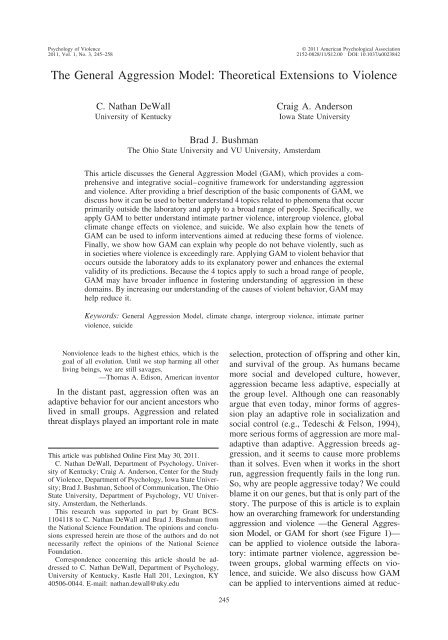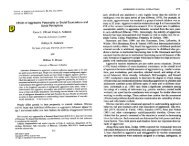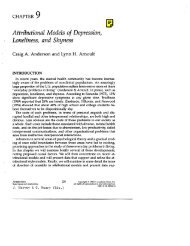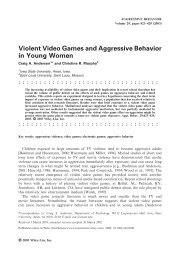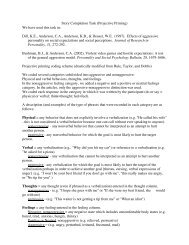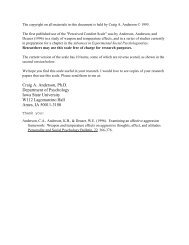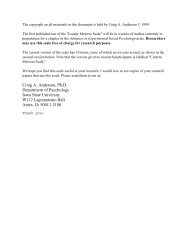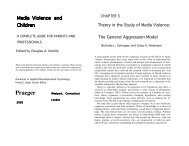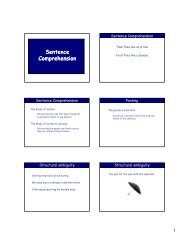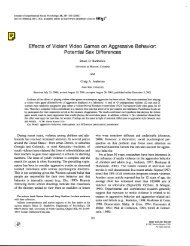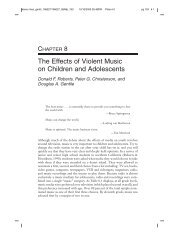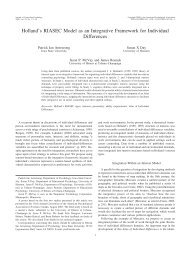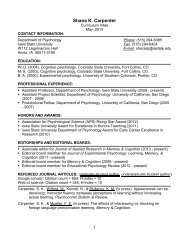The General Aggression Model: Theoretical Extensions to Violence
The General Aggression Model: Theoretical Extensions to Violence
The General Aggression Model: Theoretical Extensions to Violence
Create successful ePaper yourself
Turn your PDF publications into a flip-book with our unique Google optimized e-Paper software.
Psychology of <strong>Violence</strong> © 2011 American Psychological Association<br />
2011, Vol. 1, No. 3, 245–258 2152-0828/11/$12.00 DOI: 10.1037/a0023842<br />
<strong>The</strong> <strong>General</strong> <strong>Aggression</strong> <strong>Model</strong>: <strong>The</strong>oretical <strong>Extensions</strong> <strong>to</strong> <strong>Violence</strong><br />
C. Nathan DeWall<br />
University of Kentucky<br />
Craig A. Anderson<br />
Iowa State University<br />
Brad J. Bushman<br />
<strong>The</strong> Ohio State University and VU University, Amsterdam<br />
This article discusses the <strong>General</strong> <strong>Aggression</strong> <strong>Model</strong> (GAM), which provides a comprehensive<br />
and integrative social–cognitive framework for understanding aggression<br />
and violence. After providing a brief description of the basic components of GAM, we<br />
discuss how it can be used <strong>to</strong> better understand 4 <strong>to</strong>pics related <strong>to</strong> phenomena that occur<br />
primarily outside the labora<strong>to</strong>ry and apply <strong>to</strong> a broad range of people. Specifically, we<br />
apply GAM <strong>to</strong> better understand intimate partner violence, intergroup violence, global<br />
climate change effects on violence, and suicide. We also explain how the tenets of<br />
GAM can be used <strong>to</strong> inform interventions aimed at reducing these forms of violence.<br />
Finally, we show how GAM can explain why people do not behave violently, such as<br />
in societies where violence is exceedingly rare. Applying GAM <strong>to</strong> violent behavior that<br />
occurs outside the labora<strong>to</strong>ry adds <strong>to</strong> its explana<strong>to</strong>ry power and enhances the external<br />
validity of its predictions. Because the 4 <strong>to</strong>pics apply <strong>to</strong> such a broad range of people,<br />
GAM may have broader influence in fostering understanding of aggression in these<br />
domains. By increasing our understanding of the causes of violent behavior, GAM may<br />
help reduce it.<br />
Keywords: <strong>General</strong> <strong>Aggression</strong> <strong>Model</strong>, climate change, intergroup violence, intimate partner<br />
violence, suicide<br />
Nonviolence leads <strong>to</strong> the highest ethics, which is the<br />
goal of all evolution. Until we s<strong>to</strong>p harming all other<br />
living beings, we are still savages.<br />
—Thomas A. Edison, American inven<strong>to</strong>r<br />
In the distant past, aggression often was an<br />
adaptive behavior for our ancient ances<strong>to</strong>rs who<br />
lived in small groups. <strong>Aggression</strong> and related<br />
threat displays played an important role in mate<br />
This article was published Online First May 30, 2011.<br />
C. Nathan DeWall, Department of Psychology, University<br />
of Kentucky; Craig A. Anderson, Center for the Study<br />
of <strong>Violence</strong>, Department of Psychology, Iowa State University;<br />
Brad J. Bushman, School of Communication, <strong>The</strong> Ohio<br />
State University, Department of Psychology, VU University,<br />
Amsterdam, the Netherlands.<br />
This research was supported in part by Grant BCS-<br />
1104118 <strong>to</strong> C. Nathan DeWall and Brad J. Bushman from<br />
the National Science Foundation. <strong>The</strong> opinions and conclusions<br />
expressed herein are those of the authors and do not<br />
necessarily reflect the opinions of the National Science<br />
Foundation.<br />
Correspondence concerning this article should be addressed<br />
<strong>to</strong> C. Nathan DeWall, Department of Psychology,<br />
University of Kentucky, Kastle Hall 201, Lexing<strong>to</strong>n, KY<br />
40506-0044. E-mail: nathan.dewall@uky.edu<br />
245<br />
selection, protection of offspring and other kin,<br />
and survival of the group. As humans became<br />
more social and developed culture, however,<br />
aggression became less adaptive, especially at<br />
the group level. Although one can reasonably<br />
argue that even <strong>to</strong>day, minor forms of aggression<br />
play an adaptive role in socialization and<br />
social control (e.g., Tedeschi & Felson, 1994),<br />
more serious forms of aggression are more maladaptive<br />
than adaptive. <strong>Aggression</strong> breeds aggression,<br />
and it seems <strong>to</strong> cause more problems<br />
than it solves. Even when it works in the short<br />
run, aggression frequently fails in the long run.<br />
So, why are people aggressive <strong>to</strong>day? We could<br />
blame it on our genes, but that is only part of the<br />
s<strong>to</strong>ry. <strong>The</strong> purpose of this is article is <strong>to</strong> explain<br />
how an overarching framework for understanding<br />
aggression and violence —the <strong>General</strong> <strong>Aggression</strong><br />
<strong>Model</strong>, or GAM for short (see Figure 1)—<br />
can be applied <strong>to</strong> violence outside the labora<strong>to</strong>ry:<br />
intimate partner violence, aggression between<br />
groups, global warming effects on violence,<br />
and suicide. We also discuss how GAM<br />
can be applied <strong>to</strong> interventions aimed at reduc-
246 DEWALL, ANDERSON, AND BUSHMAN<br />
Figure 1. <strong>General</strong> aggression model.<br />
ing these forms of violence and even nonviolent<br />
behavior. Applying GAM <strong>to</strong> aggression that<br />
occurs outside the labora<strong>to</strong>ry not only adds <strong>to</strong> its<br />
explana<strong>to</strong>ry power, but it also enhances the external<br />
validity of its predictions.<br />
Psychologists have proposed a variety of theories<br />
<strong>to</strong> understand why people sometimes behave<br />
aggressively. Some examples include frustration–aggression<br />
theory (Dollard, Doob,<br />
Miller, Mowrer, & Sears, 1939), socioecological<br />
models (Heise, 1998), cognitive neoassociation<br />
theory (e.g., Berkowitz, 1989), social learning<br />
theory (e.g., Bandura, 1973; Mischel &<br />
Shoda, 1995), script theory (e.g., Huesmann,<br />
1986), excitation transfer theory (e.g., Zillmann,<br />
1983), and social interaction theory (e.g., Tedeschi<br />
& Felson, 1994). Each theory offers crucial<br />
insight in<strong>to</strong> understanding specific reasons why<br />
people behave aggressively. Yet, these minitheories<br />
do not provide an overarching framework<br />
for understanding human aggression and<br />
violence.<br />
GAM integrates minitheories of aggression<br />
in<strong>to</strong> a single conceptual framework. In so doing,<br />
GAM provides a more parsimonious model of<br />
aggression than other theories do, explains aggression<br />
that occurs because of multiple motives,<br />
and offers empirically validated insights<br />
in<strong>to</strong> ways <strong>to</strong> reduce aggression, including how<br />
<strong>to</strong> stunt the development of aggressive tendencies<br />
over time. It is the only social–cognitive<br />
model that explicitly incorporates biological,<br />
personality development, social processes, basic<br />
cognitive processes (e.g., perception, priming),<br />
short-term and long-term processes, and<br />
decision processes in<strong>to</strong> understanding aggression.<br />
<strong>The</strong>refore, GAM offers scholars a framework<br />
from which <strong>to</strong> derive and test hypotheses<br />
regarding aggression, a framework that is more<br />
expansive than any other social–cognitive<br />
model. One major focus of the present article is<br />
<strong>to</strong> show how GAM can also increase our understanding<br />
of more extreme forms of physical<br />
aggression that occur outside the labora<strong>to</strong>ry—<br />
violent behavior.<br />
GAM emphasizes three critical stages in understanding<br />
a single episodic cycle of aggression:<br />
(1) person and situation inputs, (2) present<br />
internal states (i.e., cognition, arousal, affect,<br />
including brain activity), and (3) outcomes of<br />
appraisal and decision-making processes. A<br />
feedback loop can influence future cycles of<br />
aggression, which can produce a violence escalation<br />
cycle (Anderson, Buckley, & Carnagey,<br />
2008; DeWall & Anderson, 2011). Several articles<br />
provide further insight in<strong>to</strong> these basic<br />
tenets of GAM (Anderson & Bushman, 2002;<br />
DeWall & Anderson, 2011).<br />
Applications of GAM<br />
GAM has received consistent support as a<br />
general model of aggression (for reviews, see<br />
Anderson & Bushman, 2002; DeWall & Anderson,<br />
2011). Although it was tested primarily<br />
using labora<strong>to</strong>ry aggression experiments, it can<br />
also be applied <strong>to</strong> aggression in the “real world”<br />
outside the labora<strong>to</strong>ry. Before we go further,<br />
however, we need <strong>to</strong> define the terms aggression<br />
and violence. We define aggression as any<br />
behavior intended <strong>to</strong> harm another person who<br />
does not want <strong>to</strong> be harmed (e.g., Anderson &<br />
Bushman, 2002; Bushman & Huesmann, 2010).<br />
We define violence as any aggressive act that<br />
has as its goal extreme physical harm, such as<br />
injury or death (e.g., Anderson & Bushman,<br />
2002; Bushman & Huesmann, 2010).<br />
In this section, we include several novel extensions<br />
of how GAM can inform understanding<br />
and research investigating intimate partner<br />
violence, intergroup violence, impact of global<br />
climate change on violence, and suicide. We<br />
chose these <strong>to</strong>pics for two reasons. First, each<br />
<strong>to</strong>pic applies <strong>to</strong> phenomena that occur outside<br />
the labora<strong>to</strong>ry, thereby increasing the explana<strong>to</strong>ry<br />
potential of GAM and the external validity<br />
of its predictions. Second, each <strong>to</strong>pic relates <strong>to</strong><br />
phenomena that occur relatively frequently in
the United States and in other countries. <strong>Violence</strong><br />
between intimate partners in the United<br />
States occurs at alarmingly high rates, with over<br />
one in five of couples (Schafer, Caetano, &<br />
Clark, 1998) and over one in three college students<br />
(Straus & Ramirez, 2002) reporting at<br />
least one incident over the past year. Intergroup<br />
violence is also very common. In the 40 years<br />
after the end of World War II, there were<br />
roughly 150 wars and only 26 days of world<br />
peace (defined as the absence of international<br />
war; Sluka, 1992). In terms of global climate<br />
change, the earth is warmer now than it has<br />
been at any time in the past 2,000 years (Parry,<br />
Canziani, Palutikof, van der Linden, & Hanson,<br />
2007). However, people rarely think of the impact<br />
of climate change on violence (Anderson &<br />
DeLisi, in press). Suicide also claims the lives<br />
of over a million people each year (World<br />
Health Organization, 2008). Thus, applying<br />
GAM <strong>to</strong> understand these four <strong>to</strong>pics not only<br />
increases the explana<strong>to</strong>ry power of GAM, but it<br />
also informs consideration regarding phenomena<br />
that impact millions of people worldwide.<br />
Intimate Partner <strong>Violence</strong> (IPV)<br />
Previous research on GAM has focused primarily<br />
on aggression between strangers (e.g.,<br />
Anderson & Anderson, 2008, Study 2), but we<br />
believe that GAM can also provide a useful<br />
framework for understanding IPV. As with aggression<br />
between strangers, person and situation<br />
fac<strong>to</strong>rs play a significant role in increasing the<br />
likelihood of IPV. <strong>The</strong>re are dozens, if not hundreds,<br />
of personal fac<strong>to</strong>rs involved, including<br />
trait anger, attachment style, and alcohol abuse<br />
(e.g., Finkel, 2007; Follingstad, Bradley, Helff,<br />
& Laughlin, 2002; Holtzworth-Munroe, Bates,<br />
Smutzler, & Sandin, 1997; Schumacher, Feldbau-Kohn,<br />
Slep, & Heyman, 2001). Yet, there is<br />
little conceptual organization regarding how<br />
and why risk fac<strong>to</strong>rs influence IPV, leading<br />
some scholars <strong>to</strong> suggest that “theory and research<br />
on relationship violence remain uncohesive”<br />
(Berscheid & Regan, 2005, p. 52).<br />
Attitudes <strong>to</strong>ward violence are also useful in<br />
predicting actual aggression directed <strong>to</strong>ward an<br />
intimate partner. In one recent investigation,<br />
college students who had more positive attitudes<br />
<strong>to</strong>ward IPV were more likely <strong>to</strong> physically<br />
assault and verbally abuse their current romantic<br />
partner 14 weeks later (Fincham, Cui,<br />
SPECIAL ISSUE: GENERAL AGGRESSION MODEL<br />
247<br />
Braithwaite, & Pasley, 2008). Other research<br />
has shown that people who have permissive<br />
attitudes <strong>to</strong>ward IPV also have the highest perpetration<br />
rates (Cote, Vaillancourt, LeBlanc,<br />
Nagin, & Tremblay, 2006).<br />
Some situational fac<strong>to</strong>rs that increase aggression<br />
<strong>to</strong>ward strangers also increase IPV, such as<br />
alcohol (e.g., Hove, Parkhill, Neighbors, McConchie,<br />
& Fossos, 2010). Moreover, metaanalytic<br />
findings demonstrate that alcohol<br />
increases both male-<strong>to</strong>-female and female-<strong>to</strong>male<br />
violence (Foran & O’Leary, 2008).<br />
Situations that decrease self-control increase<br />
aggression <strong>to</strong>ward both strangers and intimate<br />
relationship partners (DeWall, Baumeister,<br />
Stillman, & Gailliot, 2007; Finkel, DeWall,<br />
Slotter, Oaten, & Foshee, 2009). For example,<br />
people who are made <strong>to</strong> feel mentally exhausted,<br />
compared with people who are not<br />
made <strong>to</strong> feel mentally exhausted, make their<br />
romantic partners endure longer painful yoga<br />
poses when the partner insults them (Finkel et<br />
al., 2009, Study 4).<br />
Affect, cognition, and arousal may also be<br />
related <strong>to</strong> IPV. Currently experienced anger, for<br />
example, is related <strong>to</strong> more aggressive verbalizations<br />
among in<strong>to</strong>xicated maritally violent<br />
men (Eckhardt, 2007). In addition, having hostile<br />
cognitive biases <strong>to</strong>ward one’s spouse is associated<br />
with perpetrating more violence<br />
against one’s partner (Fincham, Bradbury,<br />
Arias, Byrne, & Karney, 1997). Relatively little<br />
research has examined the role of arousal in<br />
IPV. In one relevant study, men who showed<br />
diminished sensitivity <strong>to</strong> their wives’ expressions<br />
of happiness (an indica<strong>to</strong>r of reduced<br />
arousal) were more likely <strong>to</strong> commit IPV compared<br />
with men who showed high sensitivity <strong>to</strong><br />
their spouse’s emotional expressions (Marshall<br />
& Holtzworth-Munroe, 2010). Future research<br />
is clearly needed on the relationship between<br />
arousal and IPV.<br />
<strong>The</strong> appraisal and decision-making component<br />
of GAM is involved in both aggression<br />
<strong>to</strong>ward strangers and <strong>to</strong>ward intimate relationship<br />
partners. When people do not have sufficient<br />
mental resources <strong>to</strong> engage in reappraisal<br />
processing, they are more likely <strong>to</strong> behave aggressively<br />
<strong>to</strong>ward their romantic partners (Finkel<br />
et al., 2009). When people are mentally<br />
exhausted, they are less likely <strong>to</strong> control their<br />
aggressive impulses when provoked. Just as exercising<br />
a muscle strengthens it, people who
248 DEWALL, ANDERSON, AND BUSHMAN<br />
exercise self-control are buffered from the negative<br />
effects of mental exhaustion on IPV (Finkel<br />
et al., 2009, Study 5). <strong>The</strong> implication is that<br />
the more self-control strength people have, the<br />
more likely they are <strong>to</strong> carefully consider the<br />
negative ramifications of their actions and <strong>to</strong><br />
choose <strong>to</strong> behave in a more thoughtful, nonaggressive<br />
manner.<br />
Thus, GAM provides a cohesive understanding<br />
regarding situational and personal attributes<br />
that elevate the likelihood of IPV, mechanisms<br />
through which aggressive urges translate in<strong>to</strong><br />
violent behavior and decision-making processes<br />
that influence whether people succumb <strong>to</strong> their<br />
aggressive urges or instead engage in thoughtful,<br />
nonaggressive behavior. Commonly used<br />
theoretical models, such as socioecological<br />
models (Heise, 1998) and social learning theory<br />
(Bandura, 1973), provide valuable insight in<strong>to</strong><br />
the causes of IPV, but they lack crucial components<br />
that limit their explana<strong>to</strong>ry power. For<br />
example, socioecological models do not examine<br />
the influence of an individual’s knowledge<br />
structures, attitudes, and beliefs on currently<br />
experienced emotions, cognitive processes, and<br />
arousal levels, and their influence on whether<br />
people engage in impulsive or thoughtful actions<br />
<strong>to</strong>ward one’s partner. Instead, socioecological<br />
models seek <strong>to</strong> understand the causes of<br />
IPV at different levels of analysis (individual,<br />
relationship, community, societal), which establishes<br />
the source of influence but does not offer<br />
clear understanding regarding the role of currently<br />
experienced emotion, cognitive processes,<br />
or arousal on appraisal and decisionmaking<br />
processes that influence whether people<br />
perpetrate IPV. Social learning theory offers a<br />
useful framework <strong>to</strong> understand risk fac<strong>to</strong>rs for<br />
aggression, but it neglects the importance of<br />
fac<strong>to</strong>rs that increase the risk for aggression that<br />
are independent of one’s learning his<strong>to</strong>ry, such<br />
as genetic predispositions known <strong>to</strong> heighten<br />
the risk for aggression (e.g., monoamine oxidase<br />
A gene, sero<strong>to</strong>nin transporter gene; Dolan,<br />
Anderson, & Deakin, 2001; McDermott, Tingley,<br />
Cowden, Frazzet<strong>to</strong>, & Johnson, 2009).<br />
GAM is a biological–social–cognitive model,<br />
which uses both learning his<strong>to</strong>ry and fac<strong>to</strong>rs not<br />
associated with one’s learning his<strong>to</strong>ry <strong>to</strong> understand<br />
why people perpetrate IPV. For these reasons,<br />
GAM offers a more comprehensive model<br />
from which <strong>to</strong> test hypotheses regarding IPV<br />
perpetration.<br />
Intergroup <strong>Violence</strong><br />
Most aggression theories attempt <strong>to</strong> explain<br />
the causes and consequences of aggression between<br />
individuals, leaving open the question of<br />
whether similar processes may be involved in<br />
explaining aggression between groups. GAM<br />
offers a useful framework for understanding<br />
how aggression between groups begins and why<br />
it persists.<br />
<strong>Aggression</strong> between groups begins as a result<br />
of characteristics that each group brings <strong>to</strong> a<br />
situation and of environmental features that increase<br />
aggression. Groups, like individuals,<br />
tend <strong>to</strong> have enduring motivations, attitudes,<br />
values, and beliefs that develop out of their<br />
prior his<strong>to</strong>ry. Indeed, research on the discontinuity<br />
effect has consistently shown that individuals<br />
have internal states that are heavily influenced<br />
by group processes (Insko, Schopler,<br />
Hoyle, Dardis, & Graetz, 1990). Other research<br />
from the attitude literature suggests that exposing<br />
people <strong>to</strong> an in-group member (e.g., a fellow<br />
member of one’s political party) causes people<br />
<strong>to</strong> express strong attitudes that support their<br />
in-group, whereas exposing people <strong>to</strong> an outgroup<br />
member has the opposite effect (Ledgerwood<br />
& Chaiken, 2007). Within the context of<br />
group aggression, the terrorist group Al Qaeda<br />
believes that an alliance between Christians and<br />
Jews threatens the future of Islam. Most people<br />
living in the United States are Christians (78%;<br />
Newport, 2009), and most people living in Israel<br />
are Jews (76%; Central Bureau of Statistics,<br />
2009). As a result, situations that signal a strong<br />
Christian–Jewish alliance, such as activities related<br />
<strong>to</strong> a coalition between the United States<br />
and Israel, may increase aggressive affect, negative<br />
attitudes, and arousal among members of<br />
Al Qaeda. <strong>The</strong>se internal states may, in turn,<br />
increase the likelihood that members of Al<br />
Qaeda will perpetrate violence against all people<br />
associated with a U.S.–Israel coalition, even<br />
bystanders and civilians.<br />
GAM’s feedback loop also explains why aggressive<br />
retaliations between groups persist.<br />
Once conflict between two groups begins, the<br />
violence escalation cycle is triggered. Group A<br />
experiences Group B’s retaliation, which causes<br />
Group A’s members <strong>to</strong> have high levels of<br />
aggressive affect, <strong>to</strong> perceive Group B as hostile<br />
and aggressive, and <strong>to</strong> experience heightened<br />
arousal. <strong>The</strong>se internal states cause members of
Group A <strong>to</strong> act impulsively on their immediate<br />
appraisal of Group B as hostile and threatening.<br />
Group B then experiences the impulsively aggressive<br />
act from Group A, which sets in motion<br />
the same set of internal states and appraisal<br />
and decision processes that result in an even<br />
more aggressive retaliation (see Figure 2). Both<br />
groups will trade increasingly aggressive retaliations<br />
back and forth, which can result in the<br />
widespread destruction of human life and property.<br />
To be sure, the feedback loop can only be<br />
applied <strong>to</strong> understand ongoing aggressive retaliations<br />
between groups. If Group A refuses <strong>to</strong><br />
respond <strong>to</strong> Group B’s provocation with aggressive<br />
retaliation, then Group A bears no responsibility<br />
for any additional aggression provocation<br />
it may experience from Group B.<br />
Thus, GAM offers a parsimonious and adequate<br />
perspective for understanding why intergroup<br />
violence begins and persists. Socioecological<br />
models and social learning theory offer<br />
useful insight in<strong>to</strong> why intergroup violence occurs,<br />
but they also suffer significant limitations<br />
in terms of the scope of their explana<strong>to</strong>ry<br />
Inappropriate<br />
over-retaliation<br />
Appropriate<br />
retaliation<br />
Inappropriate<br />
over-retaliation<br />
Unintentional<br />
Justified<br />
Relatively mild<br />
A's<br />
perspectives<br />
<strong>Violence</strong> Escalation Cycle<br />
B harms A<br />
A harms B<br />
B harms A<br />
A harms B<br />
Appropriate<br />
retaliation<br />
Inappropriate<br />
over-retaliation<br />
Appropriate<br />
retaliation<br />
Intentional<br />
Unjustified j<br />
Relatively harmful<br />
Events B's<br />
perspectives<br />
Figure 2. <strong>The</strong> violence escalation cycle. N. L. From Violent<br />
evil and the general aggression model, by C. A.<br />
Anderson and N. L. Carnagey, 2004, Chapter in A. Miller<br />
(Ed.) <strong>The</strong> Social Psychology of Good and Evil (pp. 168–<br />
192). Copyright 2004 by New York: Guilford Publications.<br />
Reprinted with permission of Guilford Press.<br />
SPECIAL ISSUE: GENERAL AGGRESSION MODEL<br />
power. From a socioecological perspective, understanding<br />
intergroup violence begins with understanding<br />
the individual within the group,<br />
then understanding that individual’s relationships<br />
with others inside and outside the group,<br />
and finally understanding the group’s relationship<br />
within society. Although these levels of<br />
analysis provide information regarding risk and<br />
resiliency fac<strong>to</strong>rs for intergroup violence, they<br />
do not offer much in the way of understanding<br />
how mechanisms through which the influence<br />
of the four-level socioecological model influences<br />
the appraisal and decision process that<br />
ultimately determines whether groups will engage<br />
in violent behavior. According <strong>to</strong> social<br />
learning theory, intergroup violence occurs in<br />
large part because members of a group are exposed<br />
<strong>to</strong> violence that taught them <strong>to</strong> solve<br />
group conflict through behaving violently. Unlike<br />
GAM, social learning theory does not emphasize<br />
the importance of personal fac<strong>to</strong>rs that<br />
enhance or diminish the effect of exposure <strong>to</strong><br />
violence on subsequent group violent behavior.<br />
GAM incorporates the best perspectives of<br />
these theoretical models, addresses their limitations,<br />
and as a result provides researchers with a<br />
strong theoretical framework from which <strong>to</strong> understand<br />
intergroup violence.<br />
Global Climate Change and <strong>Violence</strong><br />
249<br />
Global climate change and its wide-ranging<br />
environmental consequences (e.g., flooding,<br />
droughts, desertification, food and water shortages)<br />
have been recognized by numerous national,<br />
military, and international groups as a<br />
significant risk fac<strong>to</strong>r for social disorder, ecomigration<br />
conflicts, and war. Global climate<br />
change influences aggression and violence both<br />
as a proximate situational fac<strong>to</strong>r and as a distal<br />
environmental modifier. More specifically,<br />
there appear <strong>to</strong> be three main ways in which<br />
rapid global climate change (rapid in geological<br />
terms) can increase the risk of violence (Anderson<br />
& DeLisi, in press). First, there is a direct<br />
effect of heat on aggressive inclinations. This<br />
well-researched line of work has shown that<br />
uncomfortably hot temperatures can increase<br />
physical aggression in labora<strong>to</strong>ry settings and in<br />
real-world violent crime studies (Anderson,<br />
2001). Simply presenting people with words<br />
related <strong>to</strong> hot temperatures is enough <strong>to</strong> increase<br />
aggressive thoughts and hostile perceptions
250 DEWALL, ANDERSON, AND BUSHMAN<br />
(DeWall & Bushman, 2009). Second, many of<br />
the environmental risk fac<strong>to</strong>rs known <strong>to</strong> increase<br />
the likelihood of a child growing up <strong>to</strong> be<br />
an aggression-prone adult will become more<br />
widespread worldwide, especially in regions<br />
likely <strong>to</strong> experience flooding as a result of sea<br />
level increases, tropical s<strong>to</strong>rms, glacial melt,<br />
and regions likely <strong>to</strong> experience drought and<br />
resulting food and water shortages. Poor preand<br />
postnatal nutrition is known <strong>to</strong> influence a<br />
host of aggression-related competencies and<br />
proneness <strong>to</strong> violence (e.g., DeLisi, 2005; Liu,<br />
Raine, Venables, & Mednick, 2004). Indeed,<br />
recent molecular genetics studies have found<br />
specific brain chemistry-related Genetic � Environment<br />
interactions (both physical and social<br />
environments) on violent criminality (see Anderson<br />
& DeLisi, in press). Third, his<strong>to</strong>rical and<br />
contemporary research shows that rapid climate<br />
change can increase group violence. Specifically,<br />
a growing body of literature supports the<br />
notion that rapid climate change (heating or<br />
cooling) increases civil disorder, political instability,<br />
and war, mostly by creating acute and<br />
recurring resource shortages that lead <strong>to</strong> ecomigration<br />
and violent conflict. Examples include<br />
war in China during 1000–1900 A.D. (Zhang,<br />
Zhang, Lee, & He, 2007), civil war in sub-<br />
Sahara Africa (Burke, Miguel, Satyanath,<br />
Dykema, & Lobell, 2009), ecomigration and<br />
violence in Bangladesh and India, and violence<br />
associated with the U.S. Dust Bowl and Hurricane<br />
Katrina. Similarly, U.S. data reveal a robust<br />
relation between increasingly hot years and<br />
violent crime rates (Anderson, Bushman, &<br />
Groom, 1997; Anderson & DeLisi, in press).<br />
GAM does a better job of explaining the<br />
effects of climate change on violence than other<br />
theories of violence. Whereas socioecological<br />
theories of violence focus primarily on how<br />
people in one’s environment influence violence,<br />
GAM emphasizes the importance of both people<br />
in one’s environment and changes in the<br />
physical environment itself as relevant <strong>to</strong> understanding<br />
violence. Likewise, social learning<br />
theory would explain the relationship between<br />
climate change and violence as a function of<br />
observing a greater number of people behaving<br />
violently, thereby ignoring the importance of<br />
changes in the actual environment (irrespective<br />
of the people in the environment) and their<br />
influence on the higher number of people behaving<br />
violently. Thus, GAM is unique in its<br />
ability <strong>to</strong> account for changes in the environment<br />
that may have implications for increasing<br />
violence, such as increasing ambient temperatures.<br />
Suicide<br />
Why people commit suicide has puzzled social<br />
scientists for centuries. Very few interventions<br />
aimed at reducing suicide are successful<br />
(Van Orden et al., 2010). To prevent suicides,<br />
we need <strong>to</strong> know why they occur. We believe<br />
GAM can offer a powerful framework for understanding<br />
why people commit suicide.<br />
Many of the same person and situation fac<strong>to</strong>rs<br />
that increase aggression between individuals<br />
and groups also increase suicide, sometimes<br />
called self-aggression. Alcohol in<strong>to</strong>xication, for<br />
example, is common among people who die by<br />
suicide (Ohberg, Vuori, & Ojanpera, 1996).<br />
Labora<strong>to</strong>ry research has shown that in<strong>to</strong>xicated<br />
people inflict more intense shocks on themselves<br />
compared with sober people (McCloskey<br />
& Berman, 2003). Feeling rejected and lonely is<br />
also robustly associated with aggression <strong>to</strong>ward<br />
others (e.g., DeWall, Twenge, Bushman, Im, &<br />
Williams, 2010; DeWall, Twenge, Gitter, &<br />
Baumeister, 2009) and with suicide (see Van<br />
Orden et al., 2010, for a review). One longitudinal<br />
study, for example, found that feelings of<br />
loneliness at age 12–13 predicted higher suicidal<br />
risk 30 years later (Rojas & Stenberg,<br />
2010). Just as poor self-control and sero<strong>to</strong>nergic<br />
dysfunction are related <strong>to</strong> aggression against<br />
other people, they are also reliably associated<br />
with an increased risk for death by suicide (e.g.,<br />
Anisman et al., 2008; Brent et al., 1994; Renaud,<br />
Berlim, McGirr, Tousignant, & Turecki,<br />
2008).<br />
Affect, cognition, and arousal all play a crucial<br />
role in suicidal behavior. People who generally<br />
internalize their anger are also more<br />
likely <strong>to</strong> attempt suicide, which is the leading<br />
risk fac<strong>to</strong>r for suicidal completion (see Van<br />
Orden et al., 2010, for a review). Suicidal ideation<br />
refers <strong>to</strong> thoughts related <strong>to</strong> ending one’s<br />
life. <strong>The</strong> more people think about dying by<br />
suicide, the more likely they are <strong>to</strong> die by suicide<br />
(Van Orden, Merrill, & Joiner, 2005). In<br />
addition, diminished arousal <strong>to</strong> the pain and<br />
distress that are associated with suicidal behavior<br />
relate <strong>to</strong> higher numbers of suicide attempts
(Van Orden, Witte, Gordon, Bender, & Joiner,<br />
2008).<br />
Because most people have a strong fear of<br />
death, they must acquire the ability <strong>to</strong> inflict<br />
lethal self-injury through repeated exposure <strong>to</strong><br />
and habituation <strong>to</strong> fear-provoking stimuli (Van<br />
Orden et al., 2010). Simply having the desire <strong>to</strong><br />
die by suicide is not sufficient <strong>to</strong> predict who<br />
actually will die by suicide. Recurrent exposure<br />
<strong>to</strong> frightening and painful situations desensitizes<br />
people <strong>to</strong> pain and increases their risk for<br />
suicide (Nademin et al., 2008). <strong>The</strong>se findings<br />
mirror work in the aggression literature, which<br />
shows that frequent exposure <strong>to</strong> violent media<br />
desensitizes people <strong>to</strong> violent images and is<br />
associated with higher aggression <strong>to</strong>ward others<br />
(Anderson et al., 2010; Bartholow, Bushman, &<br />
Sestir, 2006).<br />
For researchers interested in understanding<br />
why people die by suicide, GAM provides a<br />
social–cognitive framework from which rich<br />
and complex hypotheses can be formulated and<br />
tested. Socioecological models of violence may<br />
identify risk fac<strong>to</strong>rs for suicide, but they do not<br />
elucidate the crucial mechanisms through which<br />
these risk fac<strong>to</strong>rs heighten the risk for suicide.<br />
Social learning theorists emphasize that exposure<br />
<strong>to</strong> others who commit suicide may heighten<br />
one’s risk for suicide, but they neglect personal<br />
fac<strong>to</strong>rs (e.g., traits, genetic polymorphisms) that<br />
may exacerbate or buffer people from this risk.<br />
In contrast, suicide researchers can use GAM<br />
<strong>to</strong> make specific predictions regarding the modera<strong>to</strong>rs<br />
and media<strong>to</strong>rs of the effects of belongingness<br />
and burdensomeness on suicidal behavior.<br />
<strong>The</strong>y can also understand how the acquired<br />
ability <strong>to</strong> inflict lethal self-injury develops, and<br />
whether experiences of lowered belongingness,<br />
which influence physical pain processes (Borsook<br />
& MacDonald, 2010; DeWall & Baumeister,<br />
2006; DeWall, MacDonald, et al., 2010;<br />
Eisenberger, Lieberman, & Williams, 2003),<br />
accelerate the development of people’s ability<br />
<strong>to</strong> commit suicide. In addition, GAM offers<br />
suicide researchers an extensive <strong>to</strong>olkit of fac<strong>to</strong>rs<br />
known <strong>to</strong> increase aggression against others<br />
(e.g., media violence) that may have a similar<br />
impact on suicidal behavior. Thus, GAM offers<br />
a more comprehensive framework for understanding<br />
suicidal behavior than existing theoretical<br />
models among researchers who wish <strong>to</strong><br />
explain why people die by suicide from a social–cognitive<br />
perspective.<br />
SPECIAL ISSUE: GENERAL AGGRESSION MODEL<br />
Using GAM <strong>to</strong> Inform <strong>Violence</strong> Prevention<br />
Programs<br />
GAM suggests that a knowledge structure<br />
approach would be a more useful means of<br />
preventing violence compared with existing<br />
models. Specifically, it suggests that individual<br />
interventions should begin with an assessment<br />
of inappropriate aggressive episodes in the individual’s<br />
life along four dimensions. <strong>The</strong> first<br />
dimension is how much hostile or agitated affect<br />
is present. <strong>The</strong> second dimension is how<br />
much a specific thought, feeling, or action has<br />
become au<strong>to</strong>matized. <strong>The</strong> third dimension is<br />
how much the primary (ultimate) goal is harming<br />
the victim versus benefitting the perpetra<strong>to</strong>r.<br />
<strong>The</strong> fourth dimension is how much the perpetra<strong>to</strong>r<br />
considers the consequences of committing<br />
the aggressive act. Doing so allows the<br />
model <strong>to</strong> avoid the problems created by various<br />
artificial dicho<strong>to</strong>mies of aggressive behavior<br />
types, such as the reactive–proactive dicho<strong>to</strong>my<br />
(Bushman & Anderson, 2001). One then could<br />
tailor the intervention <strong>to</strong> the specific aspects that<br />
appear most relevant <strong>to</strong> the individual. A GAMdirected<br />
intervention would be more likely <strong>to</strong><br />
capture all of the critical elements. In what<br />
follows, we discuss how GAM can be applied <strong>to</strong><br />
violence prevention programs for IPV, intergroup<br />
violence, global climate change-related<br />
violence, and suicide.<br />
IPV<br />
251<br />
To illustrate the explana<strong>to</strong>ry power of GAM<br />
in shaping effective interventions, consider the<br />
hypothetical scenario of an intervention <strong>to</strong> reduce<br />
violence in a man who is referred <strong>to</strong> a<br />
psychological clinic because he routinely batters<br />
his wife. Although some assessment pro<strong>to</strong>cols<br />
for preventing IPV involve setting clear-cut<br />
goals and expectations (Sonkin & Liebert,<br />
2003), they do not do so within an overarching<br />
framework that assesses inappropriate aggressive<br />
episodes in the individual’s life along the<br />
four dimensions noted above.<br />
A GAM-directed intervention would consist<br />
of five steps. First, an assessment session would<br />
measure how much hostile affect is present in<br />
the man; how much a specific thought, feeling,<br />
or action related <strong>to</strong> violence against his wife has<br />
been au<strong>to</strong>matized through repetitive exposure<br />
or practice; how much the man’s primary goal is
252 DEWALL, ANDERSON, AND BUSHMAN<br />
harming his wife versus benefitting himself<br />
(e.g., feeling a sense of power and control in the<br />
relationship); and how much the man reflects on<br />
the consequences of violently battering his wife.<br />
Second, the therapist would provide the man<br />
with strategies designed <strong>to</strong> reduce his hostile<br />
affect (e.g., distraction, relaxation) and make<br />
him aware of the specific thoughts, feelings, and<br />
behavior related <strong>to</strong> his battering behavior that<br />
have become so deeply ingrained in his everyday<br />
life that they occur au<strong>to</strong>matically. Third, the<br />
therapist would give the man strategies designed<br />
<strong>to</strong> increase his thoughtful awareness of<br />
the violent thoughts, feelings, and actions related<br />
<strong>to</strong> his wife. Fourth, the therapist would<br />
work with the man <strong>to</strong> reduce his desire <strong>to</strong> cause<br />
harm <strong>to</strong> his wife (if that is his primary goal) and<br />
<strong>to</strong> develop a list of other activities he could use<br />
<strong>to</strong> feel that he plays an important and valued<br />
role in his marriage. Fifth, the therapist would<br />
provide the man with activities designed <strong>to</strong><br />
strengthen his self-regula<strong>to</strong>ry abilities, which<br />
may increase the likelihood that he will engage<br />
in thoughtful decision-making processes when<br />
he has the urge <strong>to</strong> batter his wife. As noted<br />
earlier, practicing self-regulation reduces IPV<br />
inclinations (Finkel et al., 2009), even when<br />
people practice self-regulation in domains that<br />
are unrelated <strong>to</strong> violence. Thus, GAM can inform<br />
IPV programs that can be tailored <strong>to</strong> specific<br />
aspects that are most relevant <strong>to</strong> an individual.<br />
Intergroup <strong>Violence</strong><br />
GAM can also help explain how <strong>to</strong> s<strong>to</strong>p persistent<br />
intergroup violence. Whereas previous<br />
interventions have focused on improving relationships,<br />
increasing care and empathy, and becoming<br />
cognitively aware of one’s aggressive<br />
urges (Shechtman & Ifargan, 2009), GAM suggests<br />
that understanding how <strong>to</strong> break the violence<br />
escalation cycle may also prove a useful<br />
intervention strategy <strong>to</strong> reduce intergroup violence.<br />
According <strong>to</strong> GAM, extinguishing persistent<br />
intergroup violence should occur under<br />
the following circumstances. First, Group A<br />
may perceive that the outcome of further aggressive<br />
retaliation is sufficiently important and<br />
unsatisfying that they should engage in thoughtful,<br />
as opposed <strong>to</strong> impulsive, actions <strong>to</strong>ward<br />
Group B. Next, Group B experiences Group A’s<br />
thoughtful response, which should not increase<br />
its aggressive affect, cognition, or arousal. As a<br />
result, Group B does not perceive Group A as<br />
hostile and threatening, leading it <strong>to</strong> refrain<br />
from further aggressive retaliation. This is an<br />
upward spiral rather than a downward one<br />
(Slater, Henry, Swaim, & Anderson, 2003).<br />
Thus, intergroup violence should s<strong>to</strong>p in the<br />
appraisal and decision process component of<br />
GAM. But, of course, this can occur only if the<br />
thoughtful process results in a decision <strong>to</strong> deescalate.<br />
Frequently, in international politics,<br />
this does not happen. In fact, formal political<br />
policies frequently endorse an escalation strategy<br />
on the oft-mistaken notion that “if we show<br />
the enemy that their provocations will only hurt<br />
them more, then they will back down.” <strong>The</strong>re<br />
may be cases, however, in which extreme escalation<br />
can end a conflict because one or more<br />
parties are simply unable <strong>to</strong> continue the escalation<br />
cycle.<br />
Even in cases of vastly unequal power, however,<br />
“relative” escalation may occur (Anderson<br />
et al., 2008). That is, the weaker side may not be<br />
able <strong>to</strong> retaliate at the same level as the stronger<br />
side, but it still may retaliate more strongly than<br />
it did before. Indeed, much international terrorism<br />
has this characteristic.<br />
<strong>The</strong> Israel–Palestinian conflict offers one example<br />
of how GAM can help explain how intergroup<br />
violence begins, persists—and how it<br />
can end. This intergroup conflict erupted several<br />
decades ago when Jews and Arabs exchanged<br />
violent attacks over a strip of land, alternately<br />
called Israel or Palestine, which Jews claim is<br />
their birthright and Palestinians claim as theirs.<br />
When will the Israeli–Palestinian conflict<br />
end? A GAM-derived intervention would begin<br />
by encouraging citizens from Israel, Palestine,<br />
or both countries <strong>to</strong> perceive that the outcome of<br />
their country’s retaliation is both important and<br />
unsatisfying. When this occurs, the relenting<br />
country will engage in reappraisal processing<br />
and thoughtful nonviolent action <strong>to</strong>ward the<br />
other country. <strong>The</strong> opposing country will experience<br />
a thoughtful, as opposed <strong>to</strong> an impulsively<br />
aggressive, action from the other country,<br />
which will disrupt the internal states and appraisal<br />
and decision processes that usually accompany<br />
acts from the other group. For this <strong>to</strong><br />
happen, of course, major belief systems (knowledge<br />
structures) must change and be replaced by<br />
a set of new beliefs, especially beliefs about<br />
each other and about the efficacy of violent
competition versus nonviolent cooperation.<br />
This could be implemented through the use of<br />
advertising and marketing campaigns and<br />
changes in the public opinions and apologies<br />
expressed by political leaders.<br />
Global Climate Change and <strong>Violence</strong><br />
To curb the relationship between global climate<br />
change and violence, GAM suggests two<br />
approaches. <strong>The</strong> first involves four steps designed<br />
<strong>to</strong> reduce greenhouse gas emissions and<br />
<strong>to</strong> reduce or slow climate change. Previous research<br />
has shown that people can be motivated<br />
<strong>to</strong> invest money in a fund <strong>to</strong> encourage people<br />
<strong>to</strong> reduce fossil fuel use if doing so can foster a<br />
positive social reputation (Milinski, Semmann,<br />
Krambeck, & Marotzke, 2006). A GAMdirected<br />
intervention would extend this prior<br />
work by changing not only aspects of the social<br />
situation related <strong>to</strong> fossil fuel use but also motivating<br />
people <strong>to</strong> change their beliefs regarding<br />
global climate change and its influence on violence<br />
as opposed <strong>to</strong> other outcomes.<br />
First, widespread programs would attempt <strong>to</strong><br />
change people’s beliefs regarding the presence<br />
of global climate change and their attitudes <strong>to</strong>ward<br />
activities that would reduce global climate<br />
change. Second, programs would seek <strong>to</strong><br />
change aspects of the social situation that may<br />
increase behavior that would reduce global climate<br />
change. For example, organizations and<br />
communities can publicly reward their employees<br />
for using the fewest carbon emissions each<br />
month, which would establish a norm that limiting<br />
one’s carbon emissions would be met with<br />
social acceptance and approval. Third, a GAMdriven<br />
intervention would seek <strong>to</strong> reduce negative<br />
emotions, cognitive processes, or arousal<br />
that people may experience in response <strong>to</strong> overtures<br />
<strong>to</strong> change their behavior <strong>to</strong> reduce global<br />
climate change. Among people who report that<br />
they do not moni<strong>to</strong>r their carbon emissions because<br />
it increases their anxiety, interventionists<br />
can provide simple and easy solutions aimed at<br />
reducing anxiety or tension associated with<br />
changing their behaviors that reduce global climate<br />
change. Fourth, interventionists would<br />
seek <strong>to</strong> convince citizens that by not taking<br />
action <strong>to</strong> reduce global climate change, the result<br />
will have an important and unsatisfying<br />
effect on violence. In so doing, citizens will be<br />
motivated <strong>to</strong> engage in thoughtful action <strong>to</strong> en-<br />
SPECIAL ISSUE: GENERAL AGGRESSION MODEL<br />
gage in behaviors that will reduce global climate<br />
change. By reducing global climate<br />
change, such an intervention provides an effective<br />
means of reducing violence that occurs in<br />
its wake.<br />
<strong>The</strong> second approach involves directly addressing<br />
the violence-enhancing effects of rapid<br />
climate change. Although the basic heat effect<br />
on aggressive tendencies is likely so subtle and<br />
au<strong>to</strong>matic that it will difficult <strong>to</strong> short circuit, it<br />
may be that widespread education programs<br />
that inform people about the effects of heatinduced<br />
stress on aggression might well help<br />
some people <strong>to</strong> refrain from acting on aggressive<br />
impulses. More important, international<br />
programs can intervene on behalf of the other<br />
two climate change paths <strong>to</strong> violence. Wellmother<br />
and well-baby nutrition programs for<br />
the poor; improved birth control and family<br />
planning access and education; and improved<br />
education for all, especially for girls, can reduce<br />
the effects of poverty and climate-changeinduced<br />
food and water shortages on the development<br />
of violence-prone individuals. Similarly,<br />
large-scale investment in flood and<br />
drought control and in general environmentally<br />
sensitive economic development in regions that<br />
have subsistence economies can reduce future<br />
resource crises that otherwise are likely <strong>to</strong> precipitate<br />
ecomigration and war.<br />
Suicide<br />
253<br />
As noted earlier, suicide prevention programs<br />
are no<strong>to</strong>riously ineffective (Van Orden et al.,<br />
2010). Previously successful suicide prevention<br />
programs have involved providing people at<br />
risk for suicide with information about suicidal<br />
behavior and frequent follow-up contacts<br />
(Fleischmann et al., 2008; Mot<strong>to</strong> & Bostrom,<br />
2001), but it is unclear precisely why these<br />
interventions were successful. Because GAM<br />
focuses on understanding the mechanisms underlying<br />
suicidal behavior, it may provide a<br />
useful extension <strong>to</strong> these previous interventions.<br />
A GAM-directed intervention would take a<br />
four-pronged approach <strong>to</strong> preventing suicide.<br />
First and second, therapists would identify personal<br />
(e.g., beliefs, attitudes, traits) and social<br />
(e.g., social rejection, employment, exposure <strong>to</strong><br />
violence) fac<strong>to</strong>rs known <strong>to</strong> increase the risk for<br />
suicide. After identifying an individual’s personal<br />
and social “risk profile,” the therapist
254 DEWALL, ANDERSON, AND BUSHMAN<br />
would direct the individual <strong>to</strong> treatments directed<br />
at each specific risk fac<strong>to</strong>r. For example,<br />
individuals who have positive beliefs about suicide<br />
may be exposed <strong>to</strong> therapeutic treatment<br />
aimed at changing the individual’s suicide beliefs.<br />
Individuals who chronically feel rejected<br />
would be given opportunities for renewed affiliation,<br />
which quickly reduces the harmful effects<br />
of social rejection (DeWall, Baumeister, &<br />
Vohs, 2008; DeWall, Twenge, et al., 2010).<br />
Third, therapists would identify whether an<br />
individual possesses emotional responses, cognitive<br />
processes, or arousal levels associated<br />
with a risk for suicide. After identifying those<br />
risk fac<strong>to</strong>rs, the therapist would offer the individual<br />
treatments aimed at alleviating each risk<br />
fac<strong>to</strong>r. Among individuals who have become<br />
desensitized <strong>to</strong> graphic images and physical<br />
pain, for example, treatments would center on<br />
limiting exposure <strong>to</strong> situations that might increase<br />
such desensitization (e.g., exposure <strong>to</strong><br />
weapons, violent media) and providing medical<br />
attention <strong>to</strong> limit any physical damage that may<br />
enhance the individual’s desensitization.<br />
Fourth, therapists would motivate individuals <strong>to</strong><br />
perceive suicide as having an outcome that is<br />
deeply important and unsatisfying for them personally<br />
and their loved ones. By focusing individuals<br />
<strong>to</strong> engage in such appraisal processes,<br />
individuals may be more likely <strong>to</strong> engage in<br />
thoughtful action that does not involve suicide.<br />
Using GAM <strong>to</strong> Explain Nonviolent<br />
Behavior<br />
Whereas the previous sections have emphasized<br />
how GAM can be used <strong>to</strong> explain violence<br />
in four novel ways, this section demonstrates<br />
that GAM also can be used <strong>to</strong> explain nonviolent<br />
behavior. Most theories of violence are<br />
used <strong>to</strong> explain the causes of these behaviors in<br />
contexts in which they occur somewhat frequently.<br />
At first blush, it might seem natural for<br />
GAM <strong>to</strong> be used only <strong>to</strong> explain behavior in<br />
societies marked by relatively frequent instances<br />
of violence. We argue that GAM also<br />
may be used <strong>to</strong> explain the nonoccurrence of<br />
violence in relatively peaceful societies.<br />
<strong>The</strong>re are not very many of them, but there<br />
are some societies in which war is a foreign<br />
word and violence is extremely rare (Bonta,<br />
1997; Fry, 2007). For example, more than 100<br />
years ago, the Fipa of western Tanzania trans-<br />
formed their society from one based on violence<br />
and war <strong>to</strong> one based on nonviolence and peace.<br />
<strong>The</strong> Fipa are very competitive in their business<br />
dealings, but the competition is constructive and<br />
peaceful (Willis, 1989). Another peaceful society<br />
is the Jains of India. <strong>The</strong> Jains believe in<br />
ahimas (nonviolence), and they take vows <strong>to</strong><br />
avoid any socially harmful acts, including stealing<br />
and telling lies.<br />
But even in these largely peaceful societies,<br />
GAM can explain both the predominance of<br />
nonviolence and the rare cases in which people<br />
engage in violent and aggressive behavior. Because<br />
their lives are filled with largely cooperative<br />
and prosocial experiences, people embedded<br />
in highly peaceful societies do not develop<br />
enriched aggressive knowledge structures. As a<br />
result, violence and aggression in peaceful societies<br />
should occur primarily as a result of<br />
situational fac<strong>to</strong>rs that give rise <strong>to</strong> internal states<br />
and appraisal and decision processes associated<br />
with impulsive actions.<br />
GAM can also explain why peaceful societies<br />
remain peaceful—and how societies marked by<br />
frequent war and violence can become more<br />
peaceful. Unpleasant stimuli and interpersonal<br />
conflict are inevitable, which can increase aggressive<br />
affect, cognition, and arousal. But<br />
members of peaceful societies likely appraise<br />
the outcome of an aggressive action as a significant<br />
and unsatisfying break from norms that<br />
encourage cooperation and peaceful conflict<br />
resolution, leading them <strong>to</strong> engage in a thoughtful<br />
nonviolent action. In a similar fashion, societies<br />
marked by frequent violent conflicts can<br />
become less violent when norms that formerly<br />
advocated violence now encourage citizens <strong>to</strong><br />
exercise self-control <strong>to</strong> override their violent<br />
impulses. <strong>The</strong> eminent sociologist Norbert Elias<br />
(1969, 1982) argued that European societal<br />
norms changed from the 9th century <strong>to</strong> the 19th<br />
century <strong>to</strong> encourage people <strong>to</strong> exercise restraint<br />
over their violent impulses and <strong>to</strong> shame people<br />
who failed <strong>to</strong> do so, which Elias referred <strong>to</strong> as a<br />
“civilizing process.” Other work has shown that<br />
modern civilizations are the most peaceful in<br />
the his<strong>to</strong>ry of the world in terms of deaths by<br />
war (Keeley, 1996) and murder (Eisner, 2003),<br />
presumably as a result of changes in the situational<br />
context that encourage people <strong>to</strong> override<br />
their violent impulses. Thus, although unpleasant<br />
stimuli and interpersonal conflict pervade<br />
human life, GAM argues that appraising the
outcome of an aggressive action as important<br />
and unfulfilling can reduce the likelihood of<br />
violence and aggression even in peaceful societies.<br />
Conclusion<br />
This article has highlighted the strengths of a<br />
general theory of aggression. Specifically,<br />
GAM provides the only theoretical framework<br />
of aggression and violence that explicitly incorporates<br />
biological, personality development,<br />
social processes, basic cognitive processes,<br />
short-term and long-term processes, and decision<br />
processes. We not only have discussed the<br />
basic components of GAM, but we also have<br />
made several novel contributions <strong>to</strong> the development<br />
of GAM as a theoretical model. First,<br />
whereas GAM has been used primarily <strong>to</strong> explain<br />
aggression, we have demonstrated that<br />
GAM can also be used <strong>to</strong> explain violence.<br />
Second, GAM was developed <strong>to</strong> account for<br />
aggression between strangers, but we have<br />
shown that it can also be applied <strong>to</strong> understand<br />
IPV. Third, we have shown how GAM can help<br />
explain how changes in one’s physical environment,<br />
such as climate change, can have direct<br />
implications for the safety and sustainability of<br />
that environment by increasing violence.<br />
Fourth, we have suggested that GAM may be<br />
applied <strong>to</strong> understand violence between groups<br />
of people and suicide. Fifth, we have explained<br />
how GAM can be used <strong>to</strong> inform interventions<br />
aimed at reducing IPV, violence between<br />
groups, violence that occurs as a result of global<br />
climate change, and suicide. Sixth, this article<br />
illustrates the utility of GAM for explaining<br />
nonviolent behavior, such as that found in societies<br />
in which war and violence are extremely<br />
rare.<br />
<strong>The</strong>re are some drawbacks, however, <strong>to</strong><br />
GAM. Hints about the potential weakness of a<br />
general theory of aggression come from the<br />
attitude literature. In the attitudes domain, general<br />
attitudes can be poor predic<strong>to</strong>rs of specific<br />
behaviors (Ajzen & Fishbein, 1977). For example,<br />
a student’s attitude <strong>to</strong>ward college is a poor<br />
predic<strong>to</strong>r of whether he or she will like a particular<br />
class. Similarly, GAM was proposed <strong>to</strong><br />
offer a comprehensive, general view of human<br />
aggression. Domain-specific theories may do a<br />
better job predicting more specific behaviors.<br />
SPECIAL ISSUE: GENERAL AGGRESSION MODEL<br />
<strong>The</strong> disadvantage of domain-specific aggression<br />
theories, however, is that they cannot capture<br />
the complexity of human aggression and<br />
violence. Human behavior, including aggressive<br />
and violent behavior, is complex and is<br />
multiply determined. GAM includes most if not<br />
all of the fac<strong>to</strong>rs that can influence aggression<br />
and violence. When grappling <strong>to</strong> understand the<br />
causes of aggression, researchers and laypersons<br />
can use GAM <strong>to</strong> provide a glimpse in<strong>to</strong><br />
why a person or group behaved aggressively—<br />
and how that aggression can be reduced. Such<br />
global insights can prove very helpful <strong>to</strong> researchers<br />
working on more domain-specific<br />
models as well as practitioners involved in individual<br />
or intergroup violence. Ultimately, as<br />
we begin <strong>to</strong> understand the causes of aggression<br />
and violence, people may s<strong>to</strong>p “harming all<br />
other living beings,” which is what Thomas<br />
Edison hoped would happen one day.<br />
References<br />
255<br />
Ajzen, I., & Fishbein, M. (1977). Attitude–behavior<br />
relations: A theoretical analysis and review of empirical<br />
research. Psychological Bulletin, 84, 888–<br />
918.<br />
Anderson, C. A. (2001). Heat and violence. Current<br />
Directions in Psychological Science, 10, 33–38.<br />
Anderson, C. A., & Anderson, K. B. (2008). Men<br />
who target women: Specificity of target, generality<br />
of aggressive behavior. Aggressive Behavior, 34,<br />
605–622.<br />
Anderson, C. A., Buckley, K. E., & Carnagey, N. L.<br />
(2008). Creating your own hostile environment: A<br />
labora<strong>to</strong>ry examination of trait aggression and the<br />
violence escalation cycle. Personality and Social<br />
Psychology Bulletin, 34, 462–473.<br />
Anderson, C. A., & Bushman, B. J. (2002). Human<br />
aggression. Annual Review of Psychology, 53, 27–<br />
51.<br />
Anderson, C. A., Bushman, B. J., & Groom, R. W.<br />
(1997). Hot years and serious and deadly assault:<br />
Empirical tests of the heat hypothesis. Journal of<br />
Personality and Social Psychology, 73, 1213–<br />
1223.<br />
Anderson, C. A., & Carnagey, N. L. (2004). Violent<br />
evil and the general aggression model. In A. Miller<br />
(Ed.), <strong>The</strong> Social Psychology of Good and Evil. pp.<br />
168–192. New York: Guilford Publications.<br />
Anderson, C. A., & DeLisi, M. (in press). Implications<br />
of global climate change for violence in<br />
developed and developing countries. In J. Forgas,<br />
A. Kruglanski, & K. Williams (Eds.), Social conflict<br />
and aggression. New York: Psychology Press.
256 DEWALL, ANDERSON, AND BUSHMAN<br />
Anderson, C. A., Shibuya, A., Ihori, N., Swing, E. L.,<br />
Bushman, B. J., Sakamo<strong>to</strong>, A., . . . Saleem, M.<br />
(2010). Violent video game effects on aggression,<br />
empathy, and prosocial behavior in Eastern and<br />
Western countries. Psychological Bulletin, 136,<br />
151–173.<br />
Anisman, H., Du, L., Palkovits, M., Faludi, G., Kovacs,<br />
G. G., Szontagh-Kishazi, P., . . . Poulter,<br />
M. O. (2008). Sero<strong>to</strong>nin recep<strong>to</strong>r subtype and p11<br />
mRNA expression in stress-relevant brain regions<br />
of suicide and control subjects. Journal of Psychiatry<br />
and Neuroscience, 33, 131–141.<br />
Bandura, A. (1973). <strong>Aggression</strong>: A social learning<br />
theory analysis. Englewood Cliffs, NJ: Prentice<br />
Hall.<br />
Bartholow, B. D., Bushman, B. J., & Sestir, M. A.<br />
(2006). Chronic violent video game exposure and<br />
desensitization: Behavioral and event-related brain<br />
potential data. Journal of Experimental Social Psychology,<br />
42, 532–539.<br />
Berkowitz, L. (1989). Frustration–aggression hypothesis:<br />
Examination and reformulation. Psychological<br />
Bulletin, 106, 59–73.<br />
Berscheid, E., & Regan, P. (2005). <strong>The</strong> psychology of<br />
interpersonal relationships. New York: Prentice<br />
Hall.<br />
Bonta, B. D. (1997). Cooperation and competition in<br />
peaceful societies. Psychological Bulletin, 121,<br />
299–320.<br />
Borsook, T. K., & MacDonald, G. (2010). Mildly<br />
negative social encounters reduce physical pain<br />
sensitivity. Pain, 151, 372–377.<br />
Brent, D. A., Johnson, B. A., Perper, J., Connolly, J.,<br />
Bridge, J., Bartle, S., & Rather, C. (1994). Personality<br />
disorder, personality traits, impulsive violence,<br />
and completed suicide in adolescents.<br />
Journal of the American Academy of Child &<br />
Adolescent Psychiatry, 33, 1080–1086.<br />
Burke, M. B., Miguel, E., Satyanath, S., Dykema,<br />
J. A., & Lobell, D. B. (2009). Warming increases<br />
the risk of civil war in Africa. Proceedings of the<br />
National Academy of Sciences, USA, 106, 20670–<br />
20674.<br />
Bushman, B. J., & Anderson, C. A. (2001). Is it time<br />
<strong>to</strong> pull the plug on the hostile versus instrumental<br />
aggression dicho<strong>to</strong>my? Psychological Review,<br />
108, 273–279.<br />
Bushman, B. J., & Huesmann, L. R. (2010). <strong>Aggression</strong>.<br />
In S. T. Fiske, D. T. Gilbert, & G. Lindzey<br />
(Eds.), Handbook of social psychology (5th ed.,<br />
pp. 833–863). New York: John Wiley & Sons.<br />
Central Bureau of Statistics. (2009). Israel in figures:<br />
2009. Retrieved from http://www1.cbs.gov.il/<br />
publications/isr_in_n09e.pdf<br />
Cote, S., Vaillancourt, T., LeBlanc, J., Nagin, D. W.,<br />
& Tremblay, R. E. (2006). <strong>The</strong> development of<br />
physical aggression from <strong>to</strong>ddlerhood <strong>to</strong> preadolescence:<br />
A nationwide longitudinal study of<br />
Canadian children. Journal of Abnormal Child<br />
Psychology, 34, 71–85.<br />
DeLisi, M. (2005). Career criminals in society.<br />
Thousand Oaks, CA: Sage.<br />
DeWall, C. N., & Anderson, C. A. (2011). <strong>The</strong> <strong>General</strong><br />
<strong>Aggression</strong> <strong>Model</strong>. In M. Mikulincer & P. R.<br />
Shaver (Eds.), Understanding and reducing aggression,<br />
violence, and their consequences (pp.<br />
15–33). Washing<strong>to</strong>n, DC: American Psychological<br />
Association.<br />
DeWall, C. N., & Baumeister, R. F. (2006). Alone<br />
but feeling no pain: Effects of social exclusion on<br />
physical pain <strong>to</strong>lerance and pain threshold, affective<br />
forecasting, and interpersonal empathy. Journal<br />
of Personality and Social Psychology, 91,<br />
1–15.<br />
DeWall, C. N., Baumeister, R. F., Stillman, T. F., &<br />
Gailliot, M. T. (2007). <strong>Violence</strong> restrained: Effects<br />
of self-regula<strong>to</strong>ry capacity and its depletion on<br />
aggressive behavior. Journal of Experimental Social<br />
Psychology, 43, 62–76.<br />
DeWall, C. N., Baumeister, R. F., & Vohs, K. D.<br />
(2008). Satiated with belongingness? Effects of<br />
acceptance, rejection, and task framing on selfregula<strong>to</strong>ry<br />
performance. Journal of Personality<br />
and Social Psychology, 95, 1367–1382.<br />
DeWall, C. N., & Bushman, B. J. (2009). Hot under<br />
the collar in a lukewarm environment: Hot temperature<br />
primes increased aggressive thoughts and<br />
hostile perceptions. Journal of Experimental Social<br />
Psychology, 45, 453–459.<br />
DeWall, C. N., MacDonald, G., Webster, G. D.,<br />
Masten, C., Baumeister, R. F., Powell, C., . . .<br />
Eisenberger, N. I. (2010). Acetaminophen reduces<br />
social pain: Behavioral and neural evidence. Psychological<br />
Science, 21, 931–937.<br />
DeWall, C. N., Twenge, J. M., Bushman, B. J., Im,<br />
C., & Williams, K. D. (2010). Acceptance by one<br />
differs from acceptance by none: Applying social<br />
impact theory <strong>to</strong> the rejection–aggression link. Social<br />
Psychological and Personality Science, 1,<br />
168–174.<br />
DeWall, C. N., Twenge, J. M., Gitter, S. A., &<br />
Baumeister, R. F. (2009). It’s the thought that<br />
counts: <strong>The</strong> role of hostile cognition in shaping<br />
aggressive responses <strong>to</strong> social exclusion. Journal<br />
of Personality and Social Psychology, 96, 45–59.<br />
Dolan, M., Anderson, I. M., & Deakin, J. F. (2001).<br />
Relationship between 5-HT function and impulsivity<br />
and aggression in male offenders with personality<br />
disorders. British Journal of Psychiatry, 178,<br />
352–359.<br />
Dollard, J., Doob, L. W., Miller, N. E., Mowrer,<br />
O. H., & Sears, R. R. (1939). Frustration and<br />
aggression. New Haven, CT: Yale University<br />
Press.<br />
Eckhardt, C. I. (2007). Effects of alcohol in<strong>to</strong>xication<br />
on anger experience and expression among partner
assaultive men during anger arousal. Journal of<br />
Consulting and Clinical Psychology, 75, 61–71.<br />
Eisenberger, N. I., Lieberman, M. D., & Williams,<br />
K. D. (2003, Oc<strong>to</strong>ber 10). Does rejection hurt? An<br />
fMRI study of social exclusion. Science, 302,<br />
290–292.<br />
Eisner, M. (2003). Long-term his<strong>to</strong>rical trends in<br />
violent crime. Crime and Justice; A Review of<br />
Research, 30, 83–142.<br />
Elias, N. (1969). <strong>The</strong> civilizing process. Vol. I: <strong>The</strong><br />
his<strong>to</strong>ry of manners. Oxford, England: Blackwell.<br />
Elias, N. (1982). <strong>The</strong> civilizing process. Vol. II: State<br />
formation and civilization. Oxford, England:<br />
Blackwell.<br />
Fincham, F. D., Bradbury, T. N., Arias, I., Byrne,<br />
C. A., & Karney, B. R. (1997). Marital violence,<br />
marital distress, and attributions. Journal of Family<br />
Psychology, 11, 367–372.<br />
Fincham, F. D., Cui, M., Braithwaite, S. R., & Pasley,<br />
K. (2008). Attitudes <strong>to</strong>ward intimate partner<br />
violence in dating relationships. Psychological Assessment,<br />
20, 260–269.<br />
Finkel, E. J. (2007). Impelling and inhibiting forces<br />
in the perpetration of intimate partner violence.<br />
Review of <strong>General</strong> Psychology, 11, 193–207.<br />
Finkel, E. J., DeWall, C. N., Slotter, E. B., Oaten, M.,<br />
& Foshee, V. A. (2009). Self-regula<strong>to</strong>ry failure<br />
and intimate partner violence perpetration. Journal<br />
of Personality and Social Psychology, 97, 483–<br />
499.<br />
Fleischmann, A., Ber<strong>to</strong>lote, J. M., Wasserman, D.,<br />
De Leo, D., Bolhari, J., Botega, N. J., . . . Than,<br />
H. T. (2008). Effectiveness of brief intervention<br />
and contact for suicide attempters: A randomized<br />
controlled trial in five countries. Bulletin of the<br />
World Health Organization, 86, 703–709.<br />
Follingstad, D. R., Bradley, R. G., Helff, C. M., &<br />
Laughlin, J. E. (2002). A model for predicting<br />
dating violence: Anxious attachment, angry temperament<br />
and need for relationship control. <strong>Violence</strong><br />
and Victims, 17, 35–47.<br />
Foran, H. M., & O’Leary, K. D. (2008). Alcohol and<br />
intimate partner violence: A meta-analytic review.<br />
Clinical Psychology Review, 28, 1222–1234.<br />
Fry, D. P. (2007). Beyond war. New York: Oxford<br />
University Press.<br />
Heise, L. (1998). <strong>Violence</strong> against women: An integrated,<br />
ecological framework. <strong>Violence</strong> Against<br />
Women, 4, 262–290.<br />
Holtzworth-Munroe, A., Bates, L., Smutzler, N., &<br />
Sandin, E. (1997). A brief review of the research<br />
on husband violence. <strong>Aggression</strong> and Violent Behavior,<br />
1, 65–99.<br />
Hove, M. C. B., Parkhill, M. R., Neighbors, C.,<br />
McConchie, J. M., & Fossos, N. (2010). Alcohol<br />
consumption and intimate partner violence perpetration<br />
among college students: <strong>The</strong> role of self-<br />
SPECIAL ISSUE: GENERAL AGGRESSION MODEL<br />
257<br />
determination. Journal of Studies on Alcohol and<br />
Drugs, 71, 78–85.<br />
Huesmann, L. R. (1986). Psychological processes<br />
promoting the relation between exposure <strong>to</strong> media<br />
violence and aggressive behavior by the viewer.<br />
Journal of Social Issues, 42, 125–139.<br />
Insko, C. A., Schopler, J., Hoyle, R. H., Dardis, G. J.,<br />
& Graetz, K. A. (1990). Individual–group discontinuity<br />
as a function of fear and greed. Journal of<br />
Personality and Social Psychology, 58, 68–79.<br />
Keeley, L. H. (1996). War before civilization: <strong>The</strong><br />
myth of the peaceful savage. Oxford, England:<br />
Oxford University Press.<br />
Ledgerwood, A., & Chaiken, S. (2007). Priming us<br />
and them: Au<strong>to</strong>matic assimilation and contrast in<br />
group attitudes. Journal of Personality and Social<br />
Psychology, 93, 940–956.<br />
Liu, J., Raine, A., Venables, P. H., & Mednick, S. A.<br />
(2004). Malnutrition at age 3 years and externalizing<br />
behavior problems at ages 8, 11, and 17<br />
years. <strong>The</strong> American Journal of Psychiatry, 161,<br />
2005–2013.<br />
Marshall, A. D., & Holtzworth-Munroe, A. (2010).<br />
Recognition of wives’ emotional expressions: A<br />
mechanism in the relationship between psychopathology<br />
and intimate partner violence perpetration.<br />
Journal of Family Psychology, 24, 21–30.<br />
McCloskey, M. S., & Berman, M. E. (2003). Alcohol<br />
in<strong>to</strong>xication and self-aggressive behavior. Journal<br />
of Abnormal Psychology, 112, 306–311.<br />
McDermott, R., Tingley, D., Cowden, J., Frazzet<strong>to</strong>,<br />
G., & Johnson, D. D. P. (2009). Monoamine oxidase<br />
A gene (MAOA) predicts behavioral aggression<br />
following provocation. Proceedings of the<br />
National Academy of Sciences, USA, 106, 2118–<br />
2123.<br />
Milinski, M., Semmann, D., Krambeck, H.-J., & Marotzke,<br />
J. (2006). Stabilizing the Earth’s climate is<br />
not a losing game: Supporting evidence from public<br />
goods experiments. Proceedings of the National<br />
Academy of Sciences, USA, 103, 3994–<br />
3998.<br />
Mischel, W., & Shoda, Y. (1995). A cognitive–<br />
affective system theory of personality: Reconceptualizing<br />
situations, dispositions, dynamics, and<br />
invariance in personality structure. Psychological<br />
Review, 102, 246–268.<br />
Mot<strong>to</strong>, J. A., & Bostrom, A. G. (2001). A randomized<br />
controlled trial of postcrisis suicide prevention.<br />
Psychiatric Services, 52, 828–833.<br />
Nademin, E., Jobes, D. A., Pflanz, S. E., Jacoby,<br />
A. M., Ghahramanlou-Holloway, M., Campise, R.,<br />
. . . Johnson, L. (2008). An investigation of interpersonal–psychological<br />
variables in Air Force suicides:<br />
A controlled-comparison study. Archives of<br />
Suicide Research, 12, 309–326.<br />
Newport, F. (2009). This Christmas, 78% of Americans<br />
identify as Christian. Retrieved from http://
258 DEWALL, ANDERSON, AND BUSHMAN<br />
www.gallup.com/poll/124793/this-christmas-78americans-identify-christian.aspx<br />
Ohberg, A., Vuori, E., & Ojanpera, I. (1996). Alcohol<br />
and drugs in suicides. British Journal of Psychiatry,<br />
169, 75–80.<br />
Parry, M. L., Canziani, O. F., Palutikof, J. P., van der<br />
Linden, P. J., & Hanson, C. E. (Eds.). (2007).<br />
Intergovernmental Panel on Climate Change.<br />
Cambridge, England: Cambridge University Press.<br />
Renaud, J., Berlim, M. T., McGirr, A., Tousignant,<br />
M., & Turecki, G. (2008). Current psychiatric morbidity,<br />
aggression/impulsivity, and personality dimensions<br />
in child and adolescent suicide: A case–<br />
control study. Journal of Affective Disorders, 105,<br />
221–228.<br />
Rojas, Y., & Stenberg, S.-A. (2010). Early life circumstances<br />
and male suicide—A 30-year follow-up<br />
of a S<strong>to</strong>ckholm cohort born in 1953. Social<br />
Science & Medicine, 70, 420–427.<br />
Schafer, J., Caetano, R., & Clark, C. (1998). Rates of<br />
intimate partner violence in the United States.<br />
American Journal of Public Health, 88, 1702–<br />
1704.<br />
Schumacher, J. A., Feldbau-Kohn, S. R., Slep,<br />
A. M. S., & Heyman, R. E. (2001). Risk fac<strong>to</strong>rs for<br />
male-<strong>to</strong>-female partner physical abuse. <strong>Aggression</strong><br />
and Violent Behavior, 6, 281–352.<br />
Shechtman, Z., & Ifargan, M. (2009). School-based<br />
integrated and segregated interventions <strong>to</strong> reduce<br />
aggression. Aggressive Behavior, 35, 342–356.<br />
Slater, M. D., Henry, K. L., Swaim, R. C., & Anderson,<br />
L. L. (2003). Violent media content and aggressiveness<br />
in adolescents: A downward spiral<br />
model. Communication Research, 30, 713–736.<br />
Sluka, J. (1992). <strong>The</strong> anthropology of conflict. In C.<br />
Nordstrom & J. Martin (Eds.), <strong>The</strong> paths <strong>to</strong> domination,<br />
resistance, and terror (pp. 18–36). Berkeley:<br />
University of California Press.<br />
Sonkin, D., & Liebert, D. S. (2003). <strong>The</strong> assessment<br />
of court-mandated perpetra<strong>to</strong>rs of domestic violence.<br />
Journal of <strong>Aggression</strong>, Maltreatment, &<br />
Trauma, 6, 3–36.<br />
Straus, M. A., & Ramirez, I. L. (2002, July). Gender<br />
symmetry in prevalence, severity, and chronicity of<br />
physical aggression against dating partners by<br />
university students in Mexico and USA. Paper presented<br />
at the XV World Meeting of the International<br />
Society for Research on <strong>Aggression</strong>, Montreal,<br />
Canada.<br />
Tedeschi, J. T., & Felson, R. B. (1994). <strong>Violence</strong>,<br />
aggression, and coercive actions. Washing<strong>to</strong>n,<br />
DC: American Psychological Association.<br />
Van Orden, K. A., Merrill, K. A., & Joiner, T. E., Jr.<br />
(2005). Interpersonal–psychological precursors <strong>to</strong><br />
suicidal behavior: A theory of attempted and completed<br />
suicide. Current Psychiatry Reviews, 1,<br />
187–196.<br />
Van Orden, K. A., Witte, T. K., Cukrowicz, K. C.,<br />
Braithwaite, S. R., Selby, E. A., & Joiner, T. E., Jr.<br />
(2010). <strong>The</strong> interpersonal theory of suicide. Psychological<br />
Review, 117, 575–600.<br />
Van Orden, K. A., Witte, T. K., Gordon, K. H.,<br />
Bender, T. W., & Joiner, T. E., Jr. (2008). Suicidal<br />
desire and the capability for suicide: Tests of the<br />
interpersonal–psychological theory of suicidal behavior<br />
among adults. Journal of Consulting and<br />
Clinical Psychology, 76, 72–83.<br />
Willis, R. (1989). <strong>The</strong> “peace puzzle” in Ufipa. In S.<br />
Howell & R. Willis (Eds.), Societies at peace:<br />
Anthropological perspectives (pp. 133–145). London:<br />
Routledge.<br />
World Health Organization. (2008). Suicide statistics:<br />
Introduction. Retrieved from http://<br />
www.who.int/mental_health/ prevention/suicide/<br />
suicideprevent/en/print.html<br />
Zhang, D. D., Zhang, J., Lee, H. F., & He, Y.-Q.<br />
(2007). Climate change and war frequency in Eastern<br />
China over the last millennium. Human Ecology,<br />
35, 403–414.<br />
Zillmann, D. (1983). Arousal and aggression. In<br />
R. G. Geen & E. Donnerstein (Eds.), <strong>Aggression</strong>:<br />
<strong>The</strong>oretical and empirical reviews (Vol. 1, pp.<br />
75–102). New York: Academic Press.<br />
Received August 6, 2010<br />
Revision received March 23, 2011<br />
Accepted March 28, 2011 �


